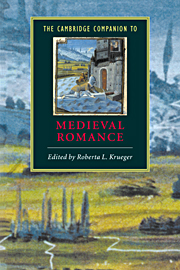Introduction
Published online by Cambridge University Press: 28 May 2006
Summary
The essays in this volume analyze critical features of what is arguably the most influential and enduring secular literary genre of the European Middle Ages. The story of medieval romance’s evolution is one of translation and transformation, adaptation and refashioning, and fertile intertextual and intercultural exchange among the linguistic and political entities of medieval Europe. Medieval romance narratives astound the modern reader by their broad circulation in France, Germany, England, The Netherlands, Italy, Scandinavia, Portugal, Greece and Spain, and by the many stories, characters, themes, and motifs they hold in common. These fictions continue to intrigue modern audiences - as they undoubtedly did medieval ones - by the diversity of their forms and subject-matter, the complexity of their narrative strategies and perspectives, and the many critical responses they invite.
Romance’s history is integrally bound up with the creation of elite lay culture in courts and wealthy households throughout the European Middle Ages. However, romance narratives are rarely simple reflections of courtly ideals. Romances of all national origins are remarkable for their authors’ capacity to remake their shared stories anew in different contexts and to reposition their ethical systems as they respond to particular audiences, in distinct geographic locations and social contexts – often with a critical perspective that calls social ideals or practices into question. The Companion to Medieval Romance is intended as an introduction to the voyages, transformations, and interrogations of romance as its fictions travel within and between the linguistic, geo-political, and social boundaries of Europe from 1150 to 1600.
- Type
- Chapter
- Information
- The Cambridge Companion to Medieval Romance , pp. 1 - 10Publisher: Cambridge University PressPrint publication year: 2000
- 5
- Cited by

